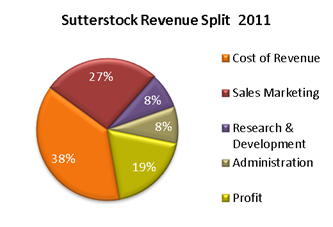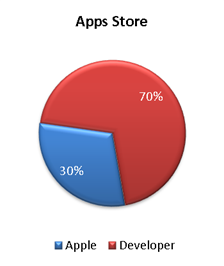 How does the money a buyer spends on an image get divided between the photographer, the agency and any middle men? The answer is reasonably straight forward; it's just sometimes not all that transparent...
How does the money a buyer spends on an image get divided between the photographer, the agency and any middle men? The answer is reasonably straight forward; it's just sometimes not all that transparent...
First, an explanation of some terminology...
Royalty - The payment a photographer (illustrator etc.) receives when an image is sold.
Commission - The money that an agency takes from the sale for conducting the transaction and to cover costs, commissions are also paid to resellers (syndication) and affiliates who find buyers.
(Traditional / macrostock agencies often listed their commission rates rather than royalty rates i.e. the amount they kept for acting as a broker)
You'll often read royalties referred to as commissions, I'm not exactly sure how this came to be, it's certainly caused confusion, and a quick look around the major microstock sites at the moment reveals phrases like 'earnings' 'and payout rates' being used to clarify the situation - it doesn't help that we working in an industry that's founded on amateur photographers and in one that is paying us 'royalties' for our 'royalty free stock' (of course that's royalty-free for the buyer).
The difference between commissions and royalties can also have important tax implications, as a contributor taking part in a referral program you might find yourself earning commissions for your referrals and royalties on your image downloads.
Although microstock/crowd-source/syndication has opened up stock photography for a huge variety of new users, it's still a vertical market - a service used by designers and agencies to source images. Keep this in mind when comparing to a horizontal market like music marketplaces (itunes etc.) which sells to anyone who has an interest in downloading music.
Also consider logistics of managing millions of products sold in 10's or 100's vs. thousands of products sold in volumes of hundreds of thousands or millions).
How is the Royalty Cake Sliced?
 There are three main expenses to consider when looking at different services that offer digital downloads and how revenue is split:
There are three main expenses to consider when looking at different services that offer digital downloads and how revenue is split:
- Money needed to run the service and perform financial transactions
- Marketing and Promotion Costs
- Royalty for the Content Creators
Each of these expenses has a matching overhead and profit margin. E.g. It might cost you 1 dollar to create a photo, but to stay in business you need to charge $2 when you sell it to pay for your next camera, put a roof over your head etc. and turn a profit.
Reselling (Syndication) & Referral Sales
These sales have different expenses for the agencies, as a 3rd party found the buyer then the direct marketing costs are zero (branding excluded) and for the case of a reseller there is no need to run a website or customer support. These sales do however generate an additional cost of referral and reseller commissions.
For reselling there's another can-of-worms to open... some agencies pay a higher rate for reseller sales (you might not actually earn more per sale) as the agency itself earns less per sale - the reseller keeps their chunk of commission. Reseller sales are different to referral sales, for referred (affiliate) sales the agency still has to provide customer support, payment processing, site access to download again etc., the reseller handles this for syndicated sales.
So, broadly speaking there are three different types of microstock buyer that earn the agencies different revenues and have different expenses:-
| Expenses \ Buyer Type | Direct Purchase | Referred Buyers | Reseller |
| Search API | Yes | Yes | Yes |
| Hosting and Bandwidth | Yes | Yes | Yes |
| Contributor Management | Yes | Yes | Yes |
| Image Review | Yes | Yes | Yes |
| Contributor Royalty | Yes | Yes | Yes |
| Website Front-end | Yes | Yes | No |
| Customer Support | Yes | Yes | No |
| Payment Processing | Yes | Yes | No |
| Marketing and PR | Yes | No | No |
| 3rd Party Commissions | No | Yes | Yes |
On top of this the agencies all have additional overheads as all companies do in finance, legal, human resources, management etc.
So How Much is Spent on Each?
That's the $64,000 dollar question. With the exception of royalty rates and 3rd party commissions the agencies keep that information quite secret. However in going public Shutterstock recently disclosed lots of interesting information in their IPO documentation. From this we can get a good idea of what a top tier microstock agency spends their revenue on:

Cost of revenue is "royalties paid to contributors, credit card processing fees, image and video review
costs, customer service expenses, the infrastructure costs related to maintaining our websites and associated employee compensation, facility costs and other supporting overhead costs" The Shutterstock IPO documentation provides full definitions of each segment of the above chart.
How Microstock Compares to Other Similar Industries
 For microstock the majority of the money is kept by the agency. There are various reasons for this, principally the fact that when sales are small then overheads from the sale start to become comparatively large. As you already know you need to sell a lot of low cost photos to pay for the cost of creating them.
For microstock the majority of the money is kept by the agency. There are various reasons for this, principally the fact that when sales are small then overheads from the sale start to become comparatively large. As you already know you need to sell a lot of low cost photos to pay for the cost of creating them.
What about other virtual goods like iTunes and apps?
Microstock seems to compare favorably. On iTunes 'artists' earn as little as 9 cents on sales of $1.29. That's the money the artist earns after the record company has taken their (sizable) bite out of the 70c that apple gives them. (These figures apply to the U.S. only). Independent artists do get to keep the whole 70c but are often charged for 'hosting' 'setup costs' annual fees etc. You can see what a large chunk is taken by transaction costs (apple) marketing costs (record label). I have read that an artist can earn up to 50% of the record company share "once the record company has recouped costs". This level of revenue split is not something new, before digital downloads the recording artist would earn only a small  fraction of the sale price of a record.
fraction of the sale price of a record.
For the Apps store Apple take a 30% commission, leaving 70% to the application publishers. Software publishers must pay for access to the software development tools ($99-$299 per year). This pricing makes it similar to the iTunes example above excluding the marketing done by the record company (i.e. independent artist). The Developer takes the 70% but must do all the marketing needed to make their application work and they are the front line for customer support. As we saw in the Shutterstock example above marketing was almost 30% of revenue. The android marketplace has the same 70% split for the developer.
But Alamy Can Pay 60% (40% Commission) on Photos?
.png) They do for their standard priced images, but it's a 50-50 split for their 'novel use' images which I think is a better comparison to microstock; and 60% commission is taken for syndicated (partner) sales. So far, Alamys primary business has not been a 'microstock' style marketplace. Alamy also have a track record of changing their commission structure as their business changes, as I think any business should - it's not just the microstock agencies that are forced to change commission structures. I don't think it's all that fair to make a direct comparison to microstock with Alamy.
They do for their standard priced images, but it's a 50-50 split for their 'novel use' images which I think is a better comparison to microstock; and 60% commission is taken for syndicated (partner) sales. So far, Alamys primary business has not been a 'microstock' style marketplace. Alamy also have a track record of changing their commission structure as their business changes, as I think any business should - it's not just the microstock agencies that are forced to change commission structures. I don't think it's all that fair to make a direct comparison to microstock with Alamy.
I don't know the full internal workings of micro or macro stock agencies, but I think it's reasonable to say that where Alamy might be able to afford to purchase an advertisement in a magazine after making a handful of sales, a microstock would probably have to sell well over 1000 images to be able to afford the same advertising outlay, the cost of getting 1000 customers is a lot higher than getting one customer. (I've ignored the fact that because prices are lower then buyers may purchase multiple microstock images; also ignored is the fact that the cost of acquiring a macrostock buyer might be significantly higher than that of a microstock buyer.)
Spend $5 via Paypal or a credit card and about 10% of the payment is swallowed in payment processing, spend several hundred dollars and that payment fee shrinks to a few per cent. This is why agencies offer discounts for credit purchases. On a microstock site a small overhead like five minutes spent replying to an email, a few minutes of time for IT support staff on a server problem can easily write off any revenue from an image sale.
History's Evidence
Clustershot were a fine example of a company that entered the market to perform transactions but not promote photographer's work. Their commission was just 12%, leaving 88% for the photographer (who also paid the Paypal processing fees) - let's call this 15%. At this level they 'broke even' and by breaking even I mean, they went out of business. "Breaking even" means no money/time/incentive to invest in the service. It would seem that 15% is not enough money to process download transactions and payments.
Alamy discontinued their Alamy Red Commission system that took 20% commission, but also incurred a $2 submission price and a monthly hosting fee.
50% royalty may seem attractive but I feel the evidence is clear that microstock agencies who do offer a flat royalty of 50% have broadly speaking stagnated. I suspect due to the agency not having resources to invest in growth. In fact looking at our royalty rate comparison all the top selling agencies (and my top earning agencies) are offering much less than 50%. That table is ordered - somewhat roughly in order of earnings for each of those sites, and broadly speaking it correlates well with increasing royalty rate - put in other words: a high royalty rate is no good whatsoever to the contributor, you are better off selling at an agency with a low royalty rate who are capable of selling more volume (and indeed do just that!).
It is common for start-up agencies to offer a larger royalty to attract sellers, wise business model or not, It's definitely not a signal to be read as "they can do it so why can't everyone". At a bare minimum agencies need to be sustainable, but they also need to be much more than that, they need to be profitable to self-invest (bootstrap if you like) to grow their business, or attract venture capital to the same end.
It seems that about 30% is a fairly standard commission to take for hosting, processing download and collecting the revenue from a virtual goods transaction. You could argue that there are some other expenses of hosting images, search might be slightly more complex.
Subsidising Higher Rates
 Some agencies offer much higher rates for exclusive images (sold for the same price) and/or higher rates to high volume sellers. While these sellers may have higher quality images resulting in a reduced review overhead, it's fairly obvious from a quick look at agency royalty rates that those who offer tiering of royalties have much lower rates for low volume sellers compared to those agencies that offer a flat rate to all. While tiering offers an incentive to upload good quality images and generate sales the lower tiers are penalised by subsidising the increased royalties of the volume sellers.
Some agencies offer much higher rates for exclusive images (sold for the same price) and/or higher rates to high volume sellers. While these sellers may have higher quality images resulting in a reduced review overhead, it's fairly obvious from a quick look at agency royalty rates that those who offer tiering of royalties have much lower rates for low volume sellers compared to those agencies that offer a flat rate to all. While tiering offers an incentive to upload good quality images and generate sales the lower tiers are penalised by subsidising the increased royalties of the volume sellers.
Weasel Words: Things to look out for when comparing royalty rates:
It's easy to assume that if an agency pays 25% royalty then when a buyer purchases an image for $5 you will receive $1.25 in royalty payment. You might be wrong, read the terms carefully and you might have left yourself open to receiving 25% of "actual revenue" "sale income" etc. Some agencies offer you a fixed $ value for each download or image size sold, comparing that to an agency that offers a % rate requires you to fully understand how their purchase system works. Do they offer discounts for bulk credit purchases and does that 'saving' pass on to you as a seller in the form of a smaller royalty?
Conclusion
Five years ago typical microstock royalties were 30-50%, since then they have been getting smaller and smaller as the agencies keep more of the revenue to themselves.
Where has it all gone? More of it is being spent on marketing, but I suspect a large chunk of it has gone onto the balance sheet to make agencies look more attractive to investors; iStock all but openly announced "we aren't making enough profit with our business" when they last changed their royalty structure.
While it might seem a good idea to 'vote with your feet' as a content creator and only upload to agencies that take lower commissions: the (perhaps sad) truth is, the agencies that have been successful, like the record companies I've mentioned in this post are the ones that invest the bulk of the revenue back into promotion and marketing.
50% of a few or no sales is far less desirable than 17% of dozens or more sales.
Photo credits: misterQM, suze, AllzweckJack / photocase.com



Interesting reading
Lee Torrens (not verified) on Tue, 2012-07-31 16:47